Understanding Kiteboard Kites: A Complete Guide
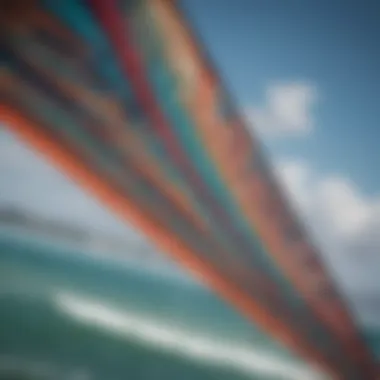
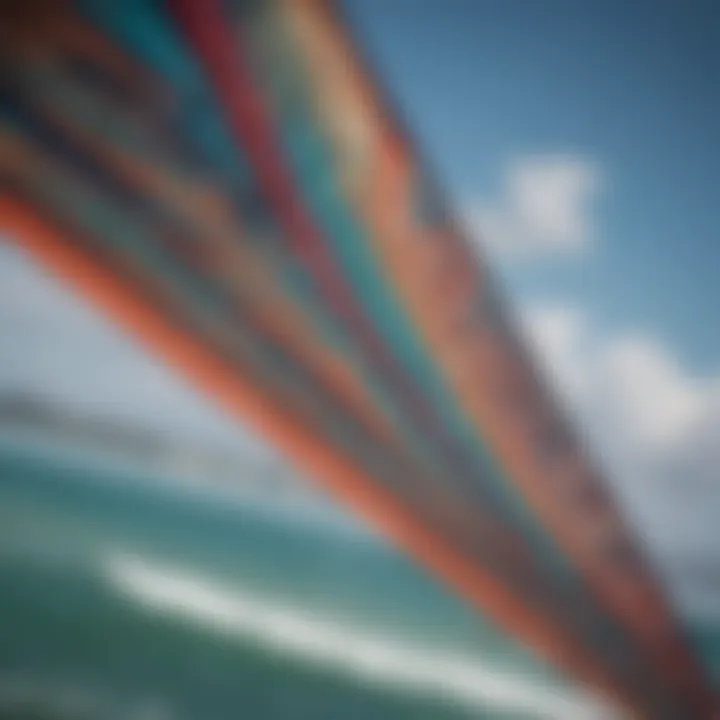
Intro
Kiteboarding captivates adventurers and thrill-seekers, merging the exhilaration of surfing with the mastery of flying. Kiteboard kites sit at the heart of this beloved watersport, each crafted with unique designs and materials that can dramatically influence a rider’s performance. Understanding the nuances of these kites is essential for enthusiasts, whether you're a newbie eager to ride the waves or a seasoned pro pushing the limits of what’s possible. The purpose of this article is to provide a thorough breakdown of kiteboard kites, from their technical aspects to practical advice that can significantly enhance one’s experience on the water.
Techniques and Skills
Essential Techniques for Beginners
For those just starting out, grasping fundamental techniques is crucial. It’s not just about flying a kite; it’s about understanding how to control it in various wind conditions.
- Body Dragging: This technique involves using the power of the kite to maneuver through the water without a board. It’s a great way to get comfortable with kite control and enhances your awareness of how the kite reacts to wind.
- Water Starts: Learning to transition from the water onto the board is a key skill. A beginner should focus on body positioning and timing. Perfecting this technique often separates the novices from the pros.
- Edge Control: Once you are up on the board, mastering edge control is essential for effective speed management and direction sailing.
Advanced Skills for Experienced Watersport Enthusiasts
For those who have mastered the basics, the world of kiteboarding offers ample opportunities for growth.
- Jumping and Tricks: Perfecting jumps requires not only skill in kite control but also in timing and body mechanics. Many riders spend hours practicing to get just a little more height or execute new tricks. It’s a thrilling way to showcase your abilities.
- Wave Riding: This combines surfing with kiteboarding for an incredibly gratifying experience. Mastering this skill involves recognizing wave patterns and adjusting kite position for optimal ride time.
- Downwinders: These are runs that take you several kilometers downwind, often allowing you to explore new terrains. Riders need advanced skills in kite control and navigation for successful downwind trips.
Equipment and Gear
Must-Have Gear for Each Watersport
Selecting the right gear is half the battle for effective kiteboarding. Here’s a snapshot of essentials:
- Kite: The kite is, of course, your primary piece of equipment. Choosing the right size and type depends on both your skill level and the prevailing wind conditions.
- Control Bar: This connects you to your kite, allowing for steering and safety releases. Make sure it fits comfortably in your hands.
- Harness: This is what connects you to the control bar. A well-fitted harness is vital for both comfort and performance.
- Board: There’s a range of boards available, from twin-tips to directional boards, each suited to different riding styles.
Tips for Selecting the Right Equipment
Choosing gear can feel daunting, especially with the plethora of options on the market. Here are a few tips that might make things easier:
- Assess Your Skills: Before buying any equipment, evaluate your skill level. Newbies may not need high-performance gear, whereas experienced riders might require advanced kites.
- Try Before You Buy: If possible, test out various kites and boards. Many shops offer demo equipment. Gaining first-hand experience with different setups can be invaluable.
- Stay Informed: Follow forums and discussions on platforms like Reddit or Facebook. Engaging with the community can provide insights into which brands are currently making waves in the industry.
"The kite is not just a piece of equipment; it’s a tool that, if understood well, can unlock uncharted adventures on the water."
Exploring the diverse aspects of kiteboarding kites not only boosts your performance but also enriches your overall kiting journey. Every kite, every trick, and every ride leaves an impression that shapes your skills further. Keeping this in mind while investing time and effort into understanding gear will no doubt bear fruit on the water.
Intro to Kiteboard Kites
Kiteboarding appeals to thrill-seekers and water sports enthusiasts alike, thanks to the sheer excitement it offers and the unique dynamics of riding on the wind. To fully appreciate this sport, one must understand the core component: the kite itself. A well-designed kite can make the difference between a seamless ride and a frustrating experience. Each kite is crafted to harness the wind, translating its power into exhilarating motion across the water.
The different elements of kite design can enhance performance, safety, and rider control, making it essential for beginners and experienced riders to understand what differentiates one kite from another. Without a grasp of these nuances, choosing the right kiteboard kite can feel like trying to find a needle in a haystack.
As kiteboarding has developed over the years, so has the diversity of kites available. This full exploration will equip readers with knowledge about various types of kites, their unique features, and how these attributes cater to different skill levels and riding conditions.
The Evolution of Kiteboarding
Kiteboarding traces its roots back to the late 1970s, but it didn't gain popularity until the late 1990s. The evolution began with rudimentary designs, often including basic materials and limited control features. Over time, advancements in technology and engineering have led to more sophisticated designs, enhancing the overall kiteboarding experience. Well-known brands took notice, introducing features like improved aerodynamics, varying aspect ratios, and materials that could withstand the forces of nature.
For instance, the transition from the inflatable kites of the early 2000s to today’s advanced bow and delta kites showcases how innovation continually shapes the sport. One might say, it's like comparing a horse and buggy to a high-speed train. Every adjustment in design has opened new possibilities, catering to varied rider preferences.
Importance of Kites in the Sport
Kites are the lifeblood of kiteboarding, influencing everything from the thrill of the ride to the skill set required to master it. A kite's shape determines its performance in different wind conditions. Selecting the right kite can mean the difference between a smooth day on the water or battling with inconsistent power and control.
- Control: Kites provide crucial feedback to the rider, allowing for nuances in navigation and maneuvering efforts.
- Wind Harnessing: They capture wind efficiently, translating that energy into lift that propels the rider forward.
- Safety Features: Modern kites come with depower systems that allow riders to manage their speed and height, promoting safer riding.
Given the genesis and growth of the sport, understanding kites directly boosts any rider's learning curve and enjoyment. A well-selected kite can turn a novice into a competent rider much faster than one ill-suited to the conditions or skill level.
"Kiteboarding is an ongoing dialogue between the rider and the wind, where kites are the voice that brings this excitement to life."
Types of Kiteboard Kites
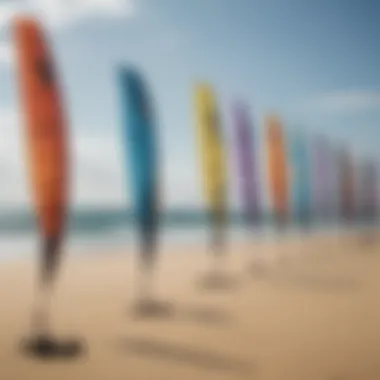
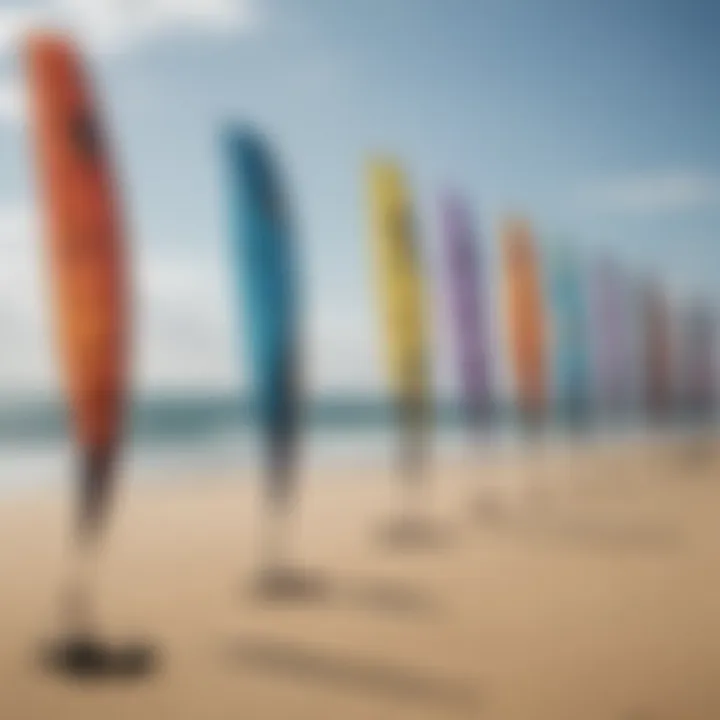
In the realm of kiteboarding, selecting the right type of kite is paramount. Each type of kite offers distinct features tailored to cater to various riding styles, wind conditions, and skill levels. Understanding these types not only enhances the riding experience but also contributes significantly to safety and performance on the water. Here, we’ll delve into three primary types of kiteboard kites, each possessing specific characteristics that can influence the dynamics of the sport.
Bow Kites
Bow Kites are a popular choice among kiteboarders due to their remarkable ability to generate lift and control power through varied wind conditions. They feature a flat design with a curved leading edge that creates a large surface area, enabling them to catch wind efficiently. One key benefit of Bow Kites is their depower capability. Riders can adjust the kite’s power with ease, allowing for smoother handling, especially in gusty conditions.
Their performance shines in lighter winds, where they maintain excellent control and responsiveness. Moreover, the stability they offer makes them suitable for beginners and advanced riders alike. Some may argue that the larger size can bring challenging dynamics, but this very attribute enables riders to experience a broader range of conditions, making every outing unpredictable yet thrilling.
Kites
C Kites have earned their reputation for providing explosive power and intense speed. Characterized by a concave shape, they’re favored often by freestyle enthusiasts who crave boosting and tricks. These kites excel in strong winds, enabling riders to harness maximum performance when the breeze picks up. However, mastering a C Kite can be daunting for those new to the sport.
The kite’s more direct control and responsiveness typically require skill and experience. One of the key perks of C Kites is their streamlined design, which allows for unmatched maneuverability. Riders will often find that these kites facilitate robust aerial tricks, granting them a competitive edge on the water.
Delta Kites
Delta Kites represent a happy medium between Bow and C kites, offering a bit of the best of both worlds. They are characterized by their triangular shape and wide wingspan. One notable feature of Delta Kites is that they excel in both low and high wind conditions, giving riders versatility in their choices.
The design, while ensuring great stability, allows for easy relaunch from the water—a feature especially appreciated by those who encounter tricky conditions. Riders looking for a steady and forgiving kite might lean toward this type, as they provide smooth gliding experiences without sacrificing power. They are user-friendly, making them a solid option for intermediate riders aiming to build their skills further.
Shape and Design Variations
Different shapes and designs in kiteboarding can drastically affect performance and usability. Aside from the main types, kite manufacturers continually explore innovations to enhance efficiency, safety, and rider experience. Here are some specific design variations worth noting:
- Aspect Ratio: The ratio of the width of the kite to its height can determine speed and maneuverability. High aspect ratio kites are designed for speed and light wind performance but may sacrifice stability.
- Wingtip Configuration: Wingtip shapes play a significant role in the kite's steering characteristics and its ability to perform in various conditions. Some kites have rigid wingtips, while others are designed to flex, adjusting control dynamics based on wind strength.
- Material Textures: Advances in fabric technology have produced kites that are lighter yet more durable. Textured materials can enhance aerodynamics and minimize turbulence.
Ultimately, the type of kite and its design should reflect the rider's skill level, preferences, and typical riding conditions. Whether you’re carving waves or learning aerial tricks, selecting the right kite is essential for a fulfilling kiteboarding experience.
"Choosing the right kite is like picking the right tool for a job; it can make all the difference in your performance and enjoyment."
Whether you're a beginner or a seasoned veteran, understanding these varieties allows for better-informed decisions, ensuring that every ride is both exhilarating and safe.
The Mechanics of Kiteboard Kites
Understanding the mechanics involved in kiteboard kites is crucial for anyone looking to engage seriously with this thrilling sport. Mechanics dictate how a kite behaves in the air, influencing not only its performance but also the overall experience of the rider. Key elements such as wind generation and lift, control and handling capabilities, and depower systems are determining factors for kite efficiency and rider safety. For those eager to master kiteboarding or simply have a great time on the water, grasping these mechanics can enhance one's understanding and effectiveness while flying.
Wind Generation and Lift
Wind generation is the lifeblood of kiteboarding; without it, there’s no lift, and without lift, there’s no kiteboarding. When a kite is flown, it interacts with the wind in specific ways that create lift. First off, the design of the kite plays a vital role. Kites with a good aerodynamic shape allow the wind to flow cleanly over their surface.
As the wind moves over the kite, it creates an area of low pressure above the kite and higher pressure below it. This difference in pressure is what pulls the kite skyward. Interestingly, the angle at which the kite is held against the wind (often referred to as the angle of attack) can significantly impact lift.
"The way a kite catches the wind is similar to how wings on an airplane work; it’s all about that pressure dance!"
Factors like the wind speed and the kite's size also come into play. A larger kite provides more surface area for the wind to act upon, generating greater lift, particularly in lighter winds. On the flip side, too much wind can lift a smaller kite very effectively but might also lead to risky situations if the rider isn’t experienced enough to manage the power.
Control and Handling
Control and handling are where the art of kiteboarding truly shines. It’s not just about going up and down; it's about maneuvering the kite with finesse and confidence. The key component here is the control bar and lines. They allow the rider to steer and adjust the kite's position in the wind.
The responsiveness of a kite can vary greatly among different designs. Some kites are characterized by their quick turning capabilities, allowing for agile maneuvers and tricks. Others might be designed for stability and ease of use in varying conditions, particularly for those starting their journey in kite surfing. A well-handled kite can dance through the air, riding the winds effortlessly, while an ill-handled one can lead to tension and confusion.
Another layer to control is the rider's body positioning. Weight distribution and shifting one’s weight can help control the kite's path through the sky. Riding the kite effectively involves understanding when to pull on the bar, when to release, and how to adjust stance based on wind direction and terrain. After all, kiteboarding is as much about the rider's skill as it is about the kite itself.
Depower Systems Explained
An essential feature in modern kite designs is the depower system. This system enables the kiteboarder to adjust the amount of power drawn from the kite, providing a critical safety mechanism in strong winds or tricky situations. Essentially, depower systems allow the rider to relinquish lift without shutting down the kite completely.
These systems often involve a combination of line adjustments and control bar movements. When a rider pulls on the depower strap, it alters the angle of attack, reducing lift and making the kite more manageable. This can be a lifesaver in sudden gusts of wind. Riders can thus maintain stability and control, even in swells of wind that could send them tumbling.
Understanding how to operate the depower system can mean the difference between an exhilarating ride and a hazardous one. Therefore, riders should practice this in safe conditions to master their kite’s limits. It’s a good way to beef up confidence and take handling skills to the next level.
Materials and Construction
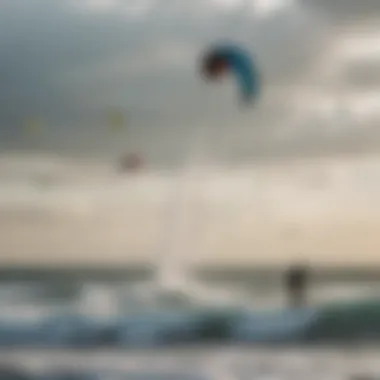
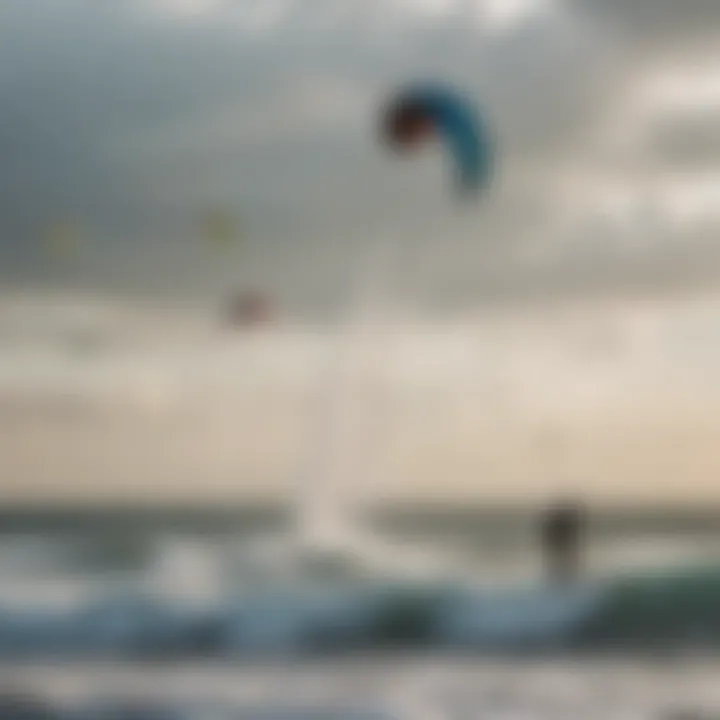
Understanding the materials and construction of kiteboard kites is crucial for both performance and safety. The right fabrics and design techniques directly impact the kite's durability, responsiveness, and overall user experience. If you're keen on diving into kiteboarding, grasping these elements will provide insight into how different kites perform under various conditions. This section will shed light on the intricate relationship between material choices and kite performance, helping you make informed decisions on the water.
Fabric Types and Their Properties
When it comes to kiteboard kites, one can't underestimate the significance of material selection. Kites are primarily made from specific fabrics that serve different purposes. The most commonly used materials are ripstop nylon and polyester. Each has its own unique properties:
- Ripstop Nylon: Known for its lightweight nature and high tensile strength, ripstop nylon minimizes the risk of tearing while keeping the kite's weight down. This material is typically used in high-performance kites aimed at speed and agility.
- Polyester: Slightly heavier but also more resistant to UV degradation, polyester offers a longer lifespan when exposed to sun and saltwater. Many entry-level kites use this fabric due to its cost-effectiveness and durability.
Choosing the right fabric goes beyond just preference; it can affect how easily the kite launches and how it behaves in the air. Kites made from lighter materials will react quicker to the wind, while heavier fabrics may offer more stability in gusty conditions.
Reinforcement and Durability
Reinforcements play a vital role in ensuring that kiteboard kites can withstand the rigors of extreme conditions. The stress on kites occurs at specific points, especially where lines attach and parts of the kite meet. This is where manufacturers go the extra mile:
- Leading Edge Reinforcement: This area is often reinforced with tough materials to withstand the rigors of crashing and impact. Taking a tumble is part of the sport, and having a sturdy leading edge can make a significant difference when it comes to longevity.
- Seam Construction: Double and triple stitching is often employed to add extra strength to seams. A well-constructed seam can mitigate potential weaknesses that may cause failure mid-ride.
Durability matters not just for financial reasons; a dependable kite allows for a more engaging and less worrisome experience on the water. In discussions among enthusiasts, durability is often highlighted as a non-negotiable trait of any quality kite.
Harnessing Quality for Performance
The overall quality of materials influences kite performance significantly. For performance-seeking individuals, the kite needs to perform reliably, but also with precision and finesse. Factors that come into play include:
- Weight Distribution: Quality materials help in maintaining even weight distribution, which is crucial for kite control and responsiveness. Kites that use high-quality fabrics often have less drag, allowing for smoother flights and better handling.
- Flexibility and Stiffness: A kite must have the right balance of flexibility and stiffness, which is heavily influenced by material quality. A flexible kite handles better in lighter winds, while stiffer kites excel in stronger winds and provide more lift.
When choices about materials and construction are made with performance in mind, it makes all the difference once you hit the water. Ultimately, the right balance between durability and performance ensures an exhilarating experience without the constant worry about your gear.
"Investing in good quality materials means investing in more thrilling rides and fewer repairs."
By understanding the nuances between different fabrics and construction methods, you can choose kites that align with your riding style and aspirations. Knowledge in these aspects leads to better decision-making and enhances your connection with the kiteboarding community.
Selecting the Right Kiteboard Kite
Choosing the perfect kiteboard kite is not just about picking one that looks good; it's a bit like finding that right pair of shoes. Each kite has its own personality, designed for specific conditions and riding styles. Selecting the right kite tailored to individual needs directly influences performance and enjoyment on the water. An ill-fitting kite can lead to frustration and even accidents. Therefore, understanding the critical factors involved in kite selection is paramount for any kiteboarding enthusiast.
Skill Level Considerations
When it comes to kiteboarding, new riders and experienced veterans are often two ships passing in the night. A novice should typically seek out a kite that emphasizes stability, ease of use, and predictable behavior. For instance, larger kites, like a 12m bow kite, are generally great for beginners, providing ample lift and control while also forgiving to user errors.
For those who have mastered the basics, the conversation shifts towards performance and advanced maneuvers. Intermediate and advanced riders might prefer a kite that is more responsive and capable of handling stronger winds. C kites, for example, are well-regarded among seasoned kiteboarders due to their agility and ability to perform complex tricks.
"The right kite can make or break your session. It's critical to assess both your skill level and your riding goals before making a selection."
Conditions and Environment Factors
Weather won't be your silent partner; it demands attention when kiteboarding. Knowing the wind conditions, water type, and any obstructions around is crucial for making informed choices. If you're in flat water with light winds, a larger kite can catch the gentle breeze and provide a nice, smooth ride. On the flip side, choppy water or strong gusts might require a smaller, more controlled kite for stability.
Here are a few considerations:
- Wind Speed: As a rule of thumb, lighter winds under 15 knots favor larger kites, while stronger winds over 20 knots call for smaller kites.
- Water Conditions: Flat water is more forgiving, enabling beginners to learn, while wave riding may require kites that handle the ebb and flow efficiently.
- Obstacles: Avoid kites with longer lines in crowded areas; the risk of tangling with fellow riders or objects can be higher.
Budget and Value Assessment
When making an investment in kiteboarding gear, budget plays a pivotal role. Kites can range from a couple of hundred to a few thousand dollars, and it's crucial to gauge what will suit your needs without breaking the bank.
It's not just about the sticker price; considering the kite's durability, performance aspects, and potential resale value is equally important. For instance, opting for a reputed brand like North Kiteboarding might cost more upfront, but the longevity and reliability can save money over time due to lesser need for replacements.
Some pointers to consider:
- Start-Up Costs: Remember to factor in additional necessities like bars, harnesses, and safety gear along with the kite itself.
- Second-Hand Options: Don’t shy away from browsing the second-hand market. It could yield great deals and kickstart your gear collection.
- Trial and Test: If possible, renting kites or participating in demo days can offer insights into various models without financial commitment.
By keeping these considerations in mind, selecting the right kiteboard kite can make all the difference. The goal is to harmonize your skill level, the environment, and your budget to find the best fit that enhances your time on the water.
Safety and Best Practices
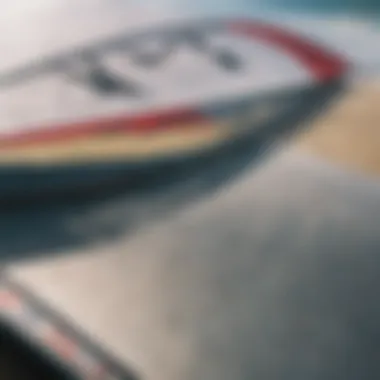

In the exhilarating sport of kiteboarding, safety can make the difference between a fun day on the water and an experience you’d rather forget. Accidents, though not common, can happen if caution is thrown to the wind. Here, we'll explore essential best practices to keep kiteboarders safe, ensuring that the thrill of the ride is both exhilarating and secure.
Equipment Checks before Kiteboarding
Before hitting the water, it’s vital to conduct a thorough equipment check. Here’s a quick rundown of what to inspect:
- Kite Integrity: Look for any tears, nicks, or damage in the fabric. A small crack can turn into a big problem at worst moments.
- Lines and Connectors: Ensure that the lines are not twisted and are free of frays. Check the connectors to make sure they're firmly attached and show no signs of wear.
- Safety Systems: Familiarize yourself with the safety systems on the kite and harness. This includes checking that quick releases work properly.
- Harness Condition: Inspect the harness for any signs of strain or wear. A broken harness can lead to loss of control.
- Board Check: Finally, don't neglect the board; ensure the fins are securely attached and there are no major scratches that might impede performance.
Taking these steps significantly reduces risks. As the old saying goes, "An ounce of prevention is worth a pound of cure."
Understanding Wind Conditions
Wind is the life source of kiteboarding, but it can also be unpredictable. Knowing how to evaluate wind conditions is crucial for a safe experience. Here are a few key considerations:
- Wind Speed: Understanding the specific wind range suitable for your kite is essential. Generally, novice riders should stay within 10-20 knots, while advanced riders may handle up to 25 knots and beyond. Too much wind can lead to overpowering situations.
- Wind Direction: Familiarize yourself with the wind direction. Is it onshore, offshore, or side-on? Each direction presents unique risks and benefits. An onshore wind is usually safer as it will blow you back to shore if something goes wrong.
- Local Conditions: Each kiteboarding location has its own unique wind patterns and hazards. Surfing through forums or local guides can provide insights on not just wind, but also the behavior of the water at different tides.
- Observation: Before launching, spend time observing the wind's behavior. Look for flags, ripples on the water, or even the way other kiters are handling their kites—your own experience can benefit from theirs.
Being informed about wind conditions can prevent accidents and make the ride much more enjoyable.
Emergency Procedures Explained
Preparation for emergencies can feel tedious but taking a few moments to know what to do when things go awry can save your life and that of others. Here’s how to be prepared:
- Know Your Quick Release: Practice using your quick release system on land. In an emergency, you don’t want to fumble.
- Practice Self-Rescue: Familiarize yourself with the self-rescue technique which involves using your board to stabilize yourself in choppy waters and pulling yourself towards your kite.
- Buddy System: Always kite with a buddy if possible. Two heads are better than one in an emergency; your partner can help you if something goes wrong.
- Communication: Always have a plan and know how to signal for help. Simple hand signals can be invaluable in crowded areas where yelling is impractical.
- Local Emergency Contacts: Make a note of local emergency contacts, including rescue services and lifeguards available in the area.
"Preparation is the key to success. In kiteboarding, it’s key to survival."
By following these guidelines, kiteboarders can mitigate risks and ensure their time on the water is fun and memorable. Remember, it’s not just about the ride; it’s about getting home safe after the thrill.
Brands and Market Overview
In the kiteboarding realm, understanding the brands behind kiteboard kites is crucial to both performance and safety. Just as a musician might choose their instrument with care, a kiteboarder needs to pick their kite wisely, considering the manufacturer's reputation and the product's reliability. This section delves into the various kite brands, what they offer, and how they impact the kites’ design and function.
Leading Kiteboard Kite Manufacturers
The kiteboard market features a blend of established names and innovative newcomers. Popular manufacturers like Naish, Cabrinha, and Duotone have made a name for themselves due to their commitment to quality and performance. Each of these brands brings unique strengths to the table, which can significantly affect a kiteboarder's experience on the water.
- Naish is often praised for its user-friendly kites that suit beginners and pros alike. Their designs focus on lift and stability, making them a popular choice.
- Cabrinha tends to shine in offering kites that excel in various wind conditions, from light breezes to stronger gusts. Their technologies blend versatility with performance, catering to many styles from freestyle to wave riding.
- Duotone, known for innovation, often pushes the envelope with features like smart bridging techniques and lightweight materials. This means enhanced responsiveness, which can curate a smoother ride.
Additionally, manufacturers like F-One and Airush have gained traction, especially in niche markets focusing on foil kites and strutless designs. These brands cater to a growing audience seeking specialized equipment. There’s a subtlety behind choosing the right manufacturer; their product ranges can influence a kiteboarder's style, skills, and even broader performance on the water.
Innovations in Kite Technology
The development of kite technology has transformed the sport, elevating the capabilities and safety of kiteboard kites. It's worth noting how modern design breakthroughs, such as higher aspect ratios and advanced fabric technologies, create better performance metrics for kiteboarders.
- Smart Pulleys: Some brands incorporate smart pulleys that provide quicker and more effective depower adjustments. This allows riders to respond swiftly to changing wind conditions, enhancing overall enjoyment and safety.
- Double Ripstop Fabric: This fabric quality not only boosts durability but also trims down weight, helping kites to catch the wind more efficiently while preventing tears that could sideline a kiteboarder unexpectedly.
- Inflatable Wing Design: Newer inflatable wings have shifted from traditional shapes to more sophisticated profiles, improving lift and control.
"Technology in kiteboarding doesn’t just improve performance. It also sets the stage for an exhilarating experience on the water. A good kite can change the way you connect with the elements!"
For anyone looking to explore more about kiteboarding or to engage with a community of enthusiasts, platforms like reddit.com offer forums where discussions about brands and technology flourish. Engaging with these discussions can provide insights into the latest trends and personal experiences from fellow kiteboarders.
Finale
In summation, as we’ve navigated through the intricacies of kiteboard kites, it’s evident how pivotal this knowledge is for both novices and seasoned riders. Understanding the components and features of kiteboard kites not only enhances performance but also enriches the overall kiteboarding experience. With a grasp of the various kite types, materials, and the mechanics at play, enthusiasts can make informed choices that significantly impact their abilities and enjoyment on the water.
Recap of Kiteboard Kite Essentials
Here’s a concise rundown of the essential points covered:
- Types of Kites: Recognizing the differences between bow kites, C kites, and delta kites is critical. Each type serves different riding styles and conditions, impacting lift and handling.
- Materials Used: The choice of fabric and construction affects durability and performance. Familiarity with materials such as ripstop nylon can guide your selection process.
- Mechanics of Lift and Control: Knowing how kites generate lift and respond to wind is crucial for mastering control and making the most of your time on the water.
- Safety Practices: Performing regular equipment checks and understanding emergency procedures ensure a safer ride. Wind conditions should never be underestimated when planning a session.
These fundamentals form the backbone of kiteboarding expertise, allowing practitioners to push their limits while remaining grounded in safety.
Looking Ahead in Kiteboarding Development
The future of kiteboarding promises exciting advancements that could redefine the sport. Innovations are not just limited to kite designs but also encompass safety features and performance enhancements. Some anticipated trends include:
- Material Innovations: As technology advances, kite materials will likely improve. We may witness lighter and stronger fabrics that enhance performance without compromising durability.
- Smart Kites: The introduction of intelligent kites, equipped with sensors to monitor wind conditions or rider performance, could provide data to enhance the riding experience.
- Eco-Friendly Options: An increasing focus on sustainable practices might see more manufacturers creating eco-friendly kites, appealing to environmentally-conscious riders.
As kiteboarding continues to gain popularity, it will be fascinating to observe how both technology and design evolve. Enthusiasts should stay engaged with industry developments to seize opportunities that arise and to maximize their enjoyment and performance.







